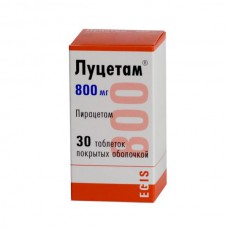Expiration date: 01/2025
The composition and form of issue:
Tablets, film-coated. 1 tablet contains:
piracetam 800 or 1200 mg
excipients: magnesium stearate povidone K-30 macrogol 6000 dibutylsebacate titanium dioxide (E171) hypromellose talc ethyl cellulose
banks in a dark glass 30 or 20 pieces in the paper cartons 1 Bank or blistere in 15 PCs (800 mg) or 10 PCs (1200 mg) in cartons of 2 (800, 1200 mg) blisters.
Solution for intravenous and intramuscular injection. 1 ml contains:
piracetam 200 mg
auxiliary substances: sodium acetate glacial acetic acid water for injections
ampoules with a volume of 5 or 15 ml in a cardboard pack of 10 (5 ml ) or 4 and 20 (15 ml) vials.
Description pharmaceutical form:
White or almost white, biconvex oval shaped tablets, coated tablets, odorless.
Pills 800 mg: with facet, scored on both sides and engraved "E 242" on one side of the tablet.
Tablets of 1200 mg: engraved with "E 243" on one side of the tablet.
The tablets on a break: the outer ring of the shell and the core of the tablet white, or almost white.
The solution for the on/in and/m introduction: a completely transparent, colorless solution (slight greenish tint), no smell.
Feature:
Cyclic derivative of GABA.
Pharmacokinetics:
If ingestion is rapidly and almost completely absorbed from the gastrointestinal tract. Cmax achieved through 1 h after administration. Bioavailability is about 100%. After ingestion of a single dose 2 g C max is 40-60 µg/ml and is achieved in the blood after 30 min and after 5 h in cerebrospinal fluid. The apparent volume of distribution of piracetam is about 0, 6 l/kg. T1/2 from plasma is 4-5 hours, from cerebrospinal fluid — 8, 5 hours.
T1/2 longer in renal failure. Pharmacokinetics of piracetam is not changed in patients with hepatic insufficiency. Piracetam penetrates through GEB, placental barrier and the membrane used in hemodialysis. Piracetam selectively accumulates in the tissues of the cerebral cortex, predominantly in the frontal, parietal and occipital lobes, the cerebellum and the basal ganglia. Not associated with blood plasma proteins, not metabolized in the body. 80-100% piracetam excreted by the kidneys unchanged by renal filtration. Renal clearance of piracetam in healthy volunteers is 86 ml/min.
Description pharmacological action:
Lucetam is a nootropic drug that acts directly on the brain. Improves these cognitive (cognitive) processes, such as learning ability, memory, attention, ability to remember, and improves mental performance, without the development of sedative and psychoactive effect. Affects the CNS in various ways: changes the speed of propagation of excitation in the brain, improves neuronal plasticity and metabolic processes in nerve cells. Improves communication between the cerebral hemispheres and the synaptic conductance in neokorticalnah structures, improves mental performance, improves cerebral blood flow.
Lucetam improves microcirculation in the brain, affecting the rheological characteristics of the blood, and causes of action of vasodilator. Inhibits platelet aggregation and restores the elasticity of the membrane of red blood cells and their ability to passage through the microvasculature. Reduces adhesion of erythrocytes. At a dose of 9, 6 g reduces the level of fibrinogen and von Willebrand factor by 30-40% and prolong bleeding time.
Lucetam exerts protective and restorative action for violation of brain function due to hypoxia, toxicity or injury. Reduces the severity and duration of vestibular nystagmus.
Indications:
- symptomatic treatment psychoorganic syndrome, particularly in elderly patients suffering from memory loss, concentration and total activity, dizziness, mood changes, conduct disorder, gait disturbance, and patients with Alzheimer's disease and senile dementia of Alzheimer's type
- the treatment of such consequences of ischemic stroke, as a violation of speech, violation of the emotional sphere, physical and mental activity
- chronic alcoholism — for the treatment psychoorganic and withdrawal syndrome
- during the recovery period after injuries and intoxication of the brain
- treatment of vertigo and related disorders of balance, with the exception of dizziness of psychic origin
- in the complex therapy of low learning ability in children, especially in the case of difficulty of acquisition of specific skills in reading, writing, and numeracy that cannot be explained by intellectual backwardness, inadequate education or family environment
- treatment of cortical myoclonia (as mono - or combined therapy).
Contraindications:
- hypersensitivity to piracetam or a derivative of pyrrolidone, as well as other components of the drug
- hemorrhagic stroke
- end-stage renal failure (Cl creatinine <20 ml/min)
- children up to age 1 year.
Application of pregnancy and breast-feeding:
Animal studies have not revealed any damaging effect on the embryo and development of the offspring, including in the postnatal period and did not change during pregnancy and childbirth.
Studies in pregnant women have not been conducted. Piracetam crosses the placental barrier and in breast milk. The concentration of the drug in the newborn reaches 70-90% of the concentration in the blood of the mother. Except in special circumstances, piracetam should not be prescribed during pregnancy.
Should refrain from breastfeeding in the appointment of a woman piracetam.
Side effects:
Table 1
| Symptoms | Common (1% to less than 10%) | Rare (0, 1% to less than 1%) |
| Disorders of the Central and peripheral nervous system | The hyperkinesis — 1, 72% | - |
| Disorders of metabolism | The increase in body mass — 1, 29% | - |
| Mental disorders | Nervousness — 1, 13% | Drowsiness — 0, 96% Depression — 0, 83% |
| Common disorder | - | Asthenia — 0, 23% |
Side effects occur more frequently in elderly patients receiving doses of more than 2, 4 g/day. In most cases it is possible to regress similar symptoms, reducing the dose of the drug. There are few reports of the following side effects: gastrointestinal — nausea, vomiting, diarrhea, abdominal pain and stomach CNS — dizziness, headaches, ataxia, impaired balance, exacerbation of epilepsy, insomnia psychiatric disorders — confusion, agitation, anxiety, hallucinations, increased sexuality on the part of the skin — dermatitis, itching, rash, swelling.
Drug interactions:
When used together with thyroid extract (T3+T4) possible increased irritability, disorientation and sleep disturbance. Not observed interaction with clonazepam, phenytoin, phenobarbital, valproate sodium.
High doses of piracetam (9, 6 g/day) increased the effectiveness of acenocoumarol in patients with venous thrombosis: observed greater reduction of platelet aggregation, fibrinogen levels, von Willebrand factor, the viscosity of the blood than in the appointment of only acenocumarol.
The ability to change the pharmacodynamics of piracetam under the influence of other drugs is low because 90% of the drug is excreted unchanged in the urine.
In vitro, piracetam does not inhibit cytochrome P450 isoforms CYP1A2, 2B6, 2C8, 2C9, 2C19, 2D6, 2E1 and 4A9/11 at concentrations of 142, 426 and 1422 µg/ml. At a concentration of 1422 µg/ml, slight inhibition of CYP2A6 (21%) and 3A4/5 (11%) (therefore, metabolic interactions with other drugs is unlikely).
Reception piracetam in a dose of 20 mg/day did not change the peak and curve of a concentration of antiepileptic drugs in serum (carbamazepine, phenytoin, phenobarbital, valproate) in epileptic patients receiving a constant dosage.
Co-administration with alcohol did not affect the concentration of piracetam in serum and the concentration of alcohol in serum was not changed to 1, 6 g of piracetam.
Method of application and dose:
Inside, during a meal or on an empty stomach with some liquid (water, juice). The daily dose — 30-160 mg/kg, reception frequency — 2-4 times per day.
In/in or/m, the daily dose — 30-160 mg/kg (3-12 g/day), the multiplicity of 2-4 times a day.
For symptomatic treatment of chronic psychoorganic set of symptoms, depending on the severity of symptoms prescribed 1, 2-2, 4 g, and within the 1st week — 4 and 8 g per day.
In the treatment of stroke is prescribed 4, 8 g/day.
In the treatment of comatose States, as well as the difficulties of perception in people with brain injuries, the initial dose is 9-12 g/day, supporting 2, 4 g/day. Treatment lasts at least 3 weeks.
When alcohol withdrawal syndrome — 12 g/day, maintenance dose — 2, 4 g/day.
Treatment of vertigo and related disorders of equilibrium — 2, 4-4, 8 g per day.
Children for the correction of low trainability dose of 3, 2 g/day. Treatment continues throughout the school year.
When cortical myoclonia treatment starts with a 7, 2 g/day every 3-4 days dose is increased by 4, 8 g/day until reaching the maximum 24 g/day. Later transferred to the oral form of Lucetam. The treatment continues throughout the period of illness. Every 6 months trying to dose reduction or discontinuation of the drug (the dose is reduced gradually by 1, 2 g every 2 days to prevent attack). With no effect or minor therapeutic effect cease treatment.
Because Lucetam excreted by the kidneys, caution should be exercised when treating patients with renal insufficiency (see table 2).
Table 2
Dosing in patients with impaired renal function
| Renal failure | Creatinine clearance, ml/min | Dosing |
| Easy | 50–79 | 2/3 of the normal dose in 2-3 doses |
| Average | 30–49 | 1/3 of normal dose in 2 hours |
| Heavy | <30 | 1/6 of the usual dose, once |
| The final stage | - | Contraindicated |
Elderly patients the dose is adjusted in the presence of renal failure, and with long-term therapy requires monitoring of the functional state of the kidneys.
Dosing in patients with impaired liver function. Patients with impaired liver function a dose adjustment is not needed. In patients with impaired functions and kidney and liver damage dosing is carried out as in patients with impaired renal function (see table. 2).
A solution of Lucetam is compatible with the following infusion solutions: dextrose (5, 10, 20%) fructose (5, 10, 20%) levulose (5%) sodium chloride (0, 9%) dextran 40 (10% 0, 9% solution NaCl) dextran 100 (6% 0, 9% NaCl) ringer solution ringer solution with lactate mannitol-dextran hydroxyethyl starch (6%).
Infusion solutions with the addition of piracetam stable for at least 24 h.
Overdose:
Treatment: if significant oral overdose — gastric lavage, induction of vomiting, symptomatic therapy, hemodialysis. The effectiveness of hemodialysis is 50-60%. There is no specific antidote.
Special instructions:
In connection with the influence of piracetam on platelet aggregation caution is recommended in appointing the drug to patients with impaired hemostasis during major surgery or in patients with symptoms of severe bleeding. In the treatment of patients cortical myoclonia should avoid abrupt interruption of treatment, which can cause the resumption of seizures.
With long-term therapy of elderly patients is recommended regular monitoring of indicators of kidney function, if necessary, conduct a correction dose depending on the results of a study in creatinine clearance.
Taking into account the possible side effects, care should be taken when performing work with machinery and driving a car.
Penetrates through the filter membrane devices for hemodialysis.




